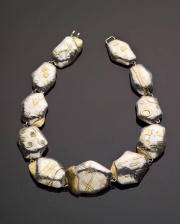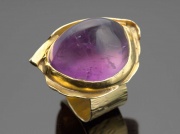Difference between revisions of "Karat"
Jump to navigation
Jump to search
| (One intermediate revision by the same user not shown) | |||
| Line 1: | Line 1: | ||
| − | [[File:2006.46-SC176531.jpg|thumb| | + | [[File:2006.46-SC176531.jpg|thumb|Necklace<br>MFA# 2006.46]] |
== Description == | == Description == | ||
| − | [[File:2006.47-SC176532.jpg| | + | [[File:2006.47-SC176532.jpg|thumb|Ring<br>MFA# 2006.47]] |
Originally a unit of weight, karat is now used as a unit of purity or quality of gold. Pure gold is 24 karat or 1000 fine and a gold alloy that contains 75% gold is 18 karat or 750 fine. The term karat was used in medieval times as a measure of the proportion of gold in a German coin called a mark that weighed 24 carat. | Originally a unit of weight, karat is now used as a unit of purity or quality of gold. Pure gold is 24 karat or 1000 fine and a gold alloy that contains 75% gold is 18 karat or 750 fine. The term karat was used in medieval times as a measure of the proportion of gold in a German coin called a mark that weighed 24 carat. | ||
| − | |||
| − | |||
== Synonyms and Related Terms == | == Synonyms and Related Terms == | ||
Latest revision as of 07:16, 16 September 2022
Description
Originally a unit of weight, karat is now used as a unit of purity or quality of gold. Pure gold is 24 karat or 1000 fine and a gold alloy that contains 75% gold is 18 karat or 750 fine. The term karat was used in medieval times as a measure of the proportion of gold in a German coin called a mark that weighed 24 carat.
Synonyms and Related Terms
k; carat (secondary spelling for gold purity); carat (Fr.); Karat (Deut.); karaat (Ned.); carate (Port.)
Resources and Citations
- Random House, Webster's Encyclopedic Unabridged Dictionary of the English Language, Grammercy Book, New York, 1997
- The American Heritage Dictionary or Encarta, via Microsoft Bookshelf 98, Microsoft Corp., 1998
- Encyclopedia Britannica, http://www.britannica.com Comment: "Karat." Accessed 2 Sept. 2004.

